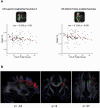Neural Correlates of Formal Thought Disorder Dimensions in Psychosis
- PMID: 36946525
- PMCID: PMC10031743
- DOI: 10.1093/schbul/sbac120
Neural Correlates of Formal Thought Disorder Dimensions in Psychosis
Abstract
Background and hypothesis: Formal thought disorder (FTD) is a core symptom of psychosis, but its neural correlates remain poorly understood. This study tested whether four FTD dimensions differ in their association with brain perfusion and brain structure.
Study design: This cross-sectional study investigated 110 patients with schizophrenia spectrum disorders using 3T magnetic resonance imaging (MRI). The Thought and Language Disorder scale (TALD) was utilized, which comprises four subscales: Objective Positive (OP), Objective Negative (ON), Subjective Positive (SP), and Subjective Negative (SN). Resting-state cerebral blood flow (rsCBF), cortical thickness (CortTh), gray matter volume (GMV), and diffusion MRI tractography were tested for associations with TALD subscales controlling for age, medication, total intracranial volume, and for variance of the 3 other TALD subscales.
Study results: Following Bonferroni correction, the FTD dimensions presented distinct neural correlates. OP scores were associated with increased rsCBF and increased GMV in the right cerebellum lingual gyrus. Higher SP scores were linked to increased GMV in bilateral prefrontal cortex. In contrast, ON was associated with increased GMV in the right premotor cortex. At more liberal statistical thresholds, higher SP was associated with increased CortTh in the right inferior frontal gyrus, whereas SN scores were linked to decreased GMV in the right prefrontal lobe, the left inferior temporal gyrus, and the left supplementary motor area. Unadjusted analyses mostly corroborated these findings.
Conclusion: These findings stress the heterogeneity in FTD, suggesting distinct neural patterns for specific FTD experiences. In sum, FTD in psychosis may require distinct treatment strategies and further mechanistic investigations on single-item levels.
Keywords: disorganization; emptiness; pathobiology.
© The Author(s) 2023. Published by Oxford University Press on behalf of the Maryland Psychiatric Research Center.
Conflict of interest statement
Sebastian Walther received honoraria from Janssen, Lundbeck, Mepha, Neurolite, and Sunovion, which are unrelated to this study. All other authors reported no potential conflicts of interest.
Figures


References
-
- Cavelti M, Homan P, Vauth R.. The impact of thought disorder on therapeutic alliance and personal recovery in schizophrenia and schizoaffective disorder: an exploratory study. Psychiatry Res. 2016;239:92–98. - PubMed
-
- Sigaudo M, Crivelli B, Castagna F, et al. . Quality of life in stable schizophrenia: the relative contributions of disorganization and cognitive dysfunction. Schizophr Res. 2014;153(1–3):196–203. - PubMed
-
- Tan EJ, Thomas N, Rossell SL.. Speech disturbances and quality of life in schizophrenia: differential impacts on functioning and life satisfaction. . Compr Psychiatry. 2014;55(3):693–698. - PubMed
Publication types
MeSH terms
Grants and funding
LinkOut - more resources
Full Text Sources
Medical
Miscellaneous

